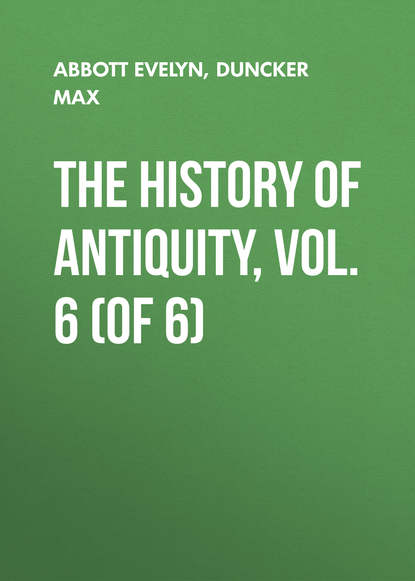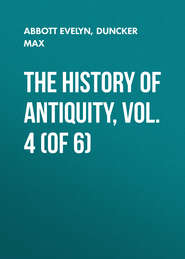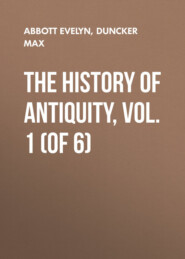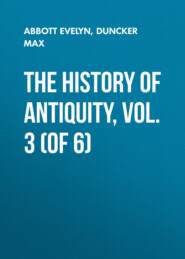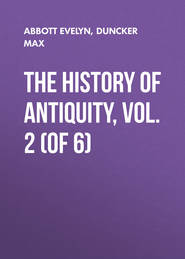По всем вопросам обращайтесь на: info@litportal.ru
(©) 2003-2024.
✖
The History of Antiquity, Vol. 6 (of 6)
Настройки чтения
Размер шрифта
Высота строк
Поля
Ctes. "Pers." 4; Fragm. 31, ed. Müller.
4
Polyaen. "Strateg." 7, 6, 3, 19; 7, 8, [Woelfflin].
5
"Cyri inst." 1, 5, 3.
6
"Cyri inst." 2, 1, 5, 6.
7
Xenoph. "Anab." 5, 5, 17. Vol. I. 257.
8
"Cyri inst." 2, 1, 5; 6, 2, 8, 9; 7, 2, 15 ff.
9
I draw this conclusion from the story of Eurybatus, which was told by Ephorus; Fragm. 100, ed. Müller.
10
Excerpt. Vatic, p. 26; "De virtute et vitiis," p. 553. [=9, 31 ff.]
11
Justin, 1, 7. Lucian ("Contemplat." 9) represents Cyrus as conquering Babylonia and then marching against Lydia.
12
[Nic. Damasc. Frag. 68, ed. Müller.]
13
"Cyri inst." 7, 2, 20.
14
Strabo, p. 575, 587.
15
Pausan. 7, 17, 9. 10.
16
Herod. 1, 131; 3, 16.
17
Marmor Parnium, ep. 41.
18
Boeckh, "Staatshaushaltung" 1. 10, 11; H. Stein on Herod. 1, 50.
19
Aristot. "Rhetor." 3, 5; Diod. Exc. Vatic. p. 25, 26[=9, 31].
20
Herod. 1, 69.
21
"Cyri inst." 6, 2, 10, 11.
22
The Parian marble mentions a mission of Crœsus to Delphi in the year 556. The date of the year for the capture of Sardis is destroyed, and cannot be even approximately restored, as the nearest dates are either mutilated or destroyed. The dates in Eusebius are derived from Apollodorus, who in turn draws from Eratosthenes. Eusebius puts the testing of the oracles in Olymp. 57,3 = 550 B.C., the march of Cyrus against Crœsus in Ol. 57,4 = 549 B.C., the capture of Crœsus in Ol. 58,3 = 546 B.C. Jerome represents Crœsus as beginning the war in Ol. 57,3 = 550 B.C. and puts his capture in Ol. 58,1 = 548 B.C. According to the statement of Syncellus (1,455, ed. Bonn.), Crœsus was defeated in the 14th year of Cyrus, which would give 547 B.C., if with Eusebius, who allows Cyrus to reign 31 years, we put his accession in 560 B.C. (V. p. 381 n.). The interval of three years which Eusebius (549-546) and two years which Jerome (550-548) places between the beginning of the war and the capture of Crœsus, appears to be due to the three years for which, according to Herodotus, Apollo delayed the overthrow of Crœsus; the presents came to Delphi three years before the fall (Herod. 1, 91). According to Herodotus the campaign occupies only one summer and autumn. The temple of Delphi was burned down in 548 B.C. (Ol. 58,1; Pausan. 10, 5, 13), and as Herodotus represents the temple as intact at the time when Crœsus sent to Delphi after his fall, this must have taken place before 548 B.C., and therefore Crœsus must have been conquered by Cyrus in 549 B.C. If the justification of the oracle in Herodotus is merely an invention of the priests, yet in things so well known the existing circumstances could not be left out of sight. It is certain that if the presents of Crœsus had been injured by the burning of the temple before his fall, this evil omen would not have been left out of sight by the legend, or by Herodotus, who himself saw and mentions the lion of Crœsus at Delphi which had been injured by the fire (1, 50). I have therefore no scruple in putting the fall of the Lydian kingdom in the year 549 B.C. Though the reign given by Herodotus for Crœsus, fourteen years and fourteen days, may have arisen out of the fourteen Lydian boys who wished to be sacrificed with their king (p. 12), yet Eusebius, Jerome, and Syncellus put the reign of Crœsus at 15 years. It may therefore be regarded as an established fact that his reign ended in the fifteenth year. According to Herodotus (1, 64, 65), it might seem as though he were of opinion that Crœsus sought allies in Hellas at the time when Pisistratus was tyrant for the third time over Athens. But this would be an error due to Herodotus' habit of anticipation. We can only be concerned with the second tyranny of Pisistratus, which belongs to the years 550 and 549 B.C. Against the argument here used – that the priests could not leave out of sight the actual circumstances in things so widely known, even in their inventions, Büdinger objects: "The chronological relations in Lydian-Persian history were neither various nor generally known, when Herodotus visited Delphi." The objection would be pertinent if the legend of the priests had only been manufactured during Herodotus' stay at Delphi, and for his use. This is not tenable. The fall of Crœsus was an event which deeply moved the Hellenic world, and created the most lively astonishment; the responses of Delphi had allured him to war; the oracle must at once justify itself if it were not to lose considerably in its authority. The justification must, therefore, have been invented at once; in the cities of Anatolia it would be best known at that time how and when the Mede came into the land with the fall of Crœsus (πηλίκος ἦσθ’ ὅθ’ ὁ Μῆδος ἀφίκετο; Xenophanes in Athenaeus, p. 54), and it was also known everywhere how long before the great presents of Crœsus had come to Miletus and Delphi. This must be noticed by the Delphian priests. But, as I have expressly said, I have not laid any great stress on this fact, but on the burning of the temple in 548 B.C., for that is the only certain point which can be gained. It does not seem possible to me to make Xenophon's account of the Lydian and Babylonian wars of Cyrus in the Cyropaedia a reason for placing the overthrow of Crœsus in 541 B.C. and putting back the beginning of the third tyranny of Pisistratus to that date in order to suit this account. There are also reasons of fact against such a date, which are given elsewhere.
23
Herod. 1, 153.
24
Plat. "Protagoras," p. 327. Demosth. "De Corona," 24; Aesch. "in Ctesiph." 137, and the Scholia.
25
Polyb. 7, 15; 8, 22.
26
Raoul Rochette, "Mémoires de l'institut," 17, 2, p. 278 ff.
27
Herod. 1, 87.
28





